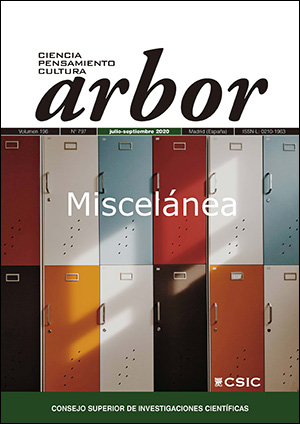Iconographic topics and material culture in a relación de fiestas in Mexico in 1621
DOI:
https://doi.org/10.3989/arbor.2020.797n3001Keywords:
Relación de fiestas, Mexico, material culture, ColoniaAbstract
If in the relaciones de fiestas, one of the identifying styles is the profuse description of all the elements that cloak the event, the text from 1621 entitled Verdadera relación de una máscara que los artífices del gremio de la platería de México y devotos del glorioso San Isidro hicieron en honra de su gloriosa beatificación is paradigmatic on the relevance of material culture to construct the image of Carlos V and all the elements in the parade. The clothing, jewels, objects are central to the iconographic building of the myth of the hero and to propagate the heroic image of Spain. This work analyses both this material culture portrayed by the text and its dimension in regard to the reception of literary and historical characters in America and the special significance the context imprints on them.
Downloads
References
Alenda y Mira, J. (1903). Relaciones de solemnidades y fiestas públicas de España. Madrid: Sucesores de Rivadeneyra.
Bonet Correa, A. (1986). Arquitecturas efímeras, ornatos y máscaras. El lugar y la teatralidad de la fiesta barroca. En: Díez Borque, J. M. (coord.). Teatro y fiesta en el Barroco. España e Iberoamérica. Madrid: Ediciones del Serbal.
Buxó, J. P. (2007). Poética del espectáculo barroco: el Neptuno alegórico de Sor Juana. En: Farré Vidal, J. (ed.). Teatro y poder en la época de Carlos II. Fiestas en torno a reyes y virreyes. Madrid: Iberoamericana / Vervuert.
Checa Cremades, F. (1987). Carlos V y la imagen del héroe en el Renacimiento. Madrid: Taurus.
Erasmo (1964). Obras escogidas. Madrid: Aguilar.
Gil, J. (1989). Mitos y utopías del descubrimiento. Madrid: Alianza.
Gisbert, T. (1983). La fiesta y la alegoría en el virreinato peruano. En El arte efímero en el mundo hispánico. V Coloquio del Instituto de Investigaciones Estéticas de la Universidad Nacional Autónoma de México, 23 al 26 de octubre de 1978, Morelia. México: Universidad Nacional Autónoma de México, pp. 145-151.
Hunter, D. E. y Whitten, P. (1981). Enciclopedia de antropología. Barcelona: Bellaterra.
Maravall, J. A. (1960). Carlos V y el pensamiento político del Renacimiento. Madrid: Instituto de Estudios Políticos.
Paz, O. (1995). Sor Juana Inés de la Cruz o las trampas de la fe. México: Fondo de Cultura Económica.
Ramos Sosa, R. (1997). La fiesta barroca en Ciudad de México y Lima. Historia, 30, pp. 263-286.
Rodríguez Abril, J. (1883). Verdadera relación de una máscara que los artífices del gremio de la platería de México y devotos del glorioso San Isidro el Labrador de Madrid, hicieron en honra de su gloriosa beatificación, por Pedro Gutiérrez, en la calle de Tamba, México, 1621. Publicado por el Conde de las Navas en Cosas de España, Rasco, Sevilla, 1891. [En línea]. Disponible en https://cvc.cervantes.es/literatura/quijote_america/ mexico/mascara.htm
Rodríguez, D. (1998). Texto y fiesta en la literatura novohispana (1650-1700). México: Universidad Nacional Autónoma de México.
Rojas Garcidueñas, J. (1972). Cervantes y don Quijote. México: Secretaría de Ecuación Pública.
Romero de Terreros, M. (marqués de San Francisco) (1918). Torneos, mascaradas y fiestas reales en la Nueva España. México: Porrua.
Sarmiento Ramírez, I. (2007). Cultura y cultura material: aproximaciones a los conceptos e inventario epistemológico. Anales del Museo de América, 15, pp. 217-236.
Solano, F. de (1990). Fiestas en la Ciudad de México: estudio historiográfico. En Solano, F. de Ciudades hispanoamericanas y pueblos de indios. Madrid: Consejo Superior de Investigaciones Científicas, pp. 247-310.
Zarco del Valle Espinosa, N. R. y López Valdemoro Quesada, J. G. (eds.) (1891). Cosas de España. Sevilla: Rasco.
Zugasti, M. (2005). La alegoría de América en el barroco hispánico: del arte efímero al teatro. Valencia: Pre-Textos.
Published
How to Cite
Issue
Section
License
Copyright (c) 2020 Consejo Superior de Investigaciones Científicas (CSIC)

This work is licensed under a Creative Commons Attribution 4.0 International License.
© CSIC. Manuscripts published in both the printed and online versions of this Journal are the property of Consejo Superior de Investigaciones Científicas, and quoting this source is a requirement for any partial or full reproduction.
All contents of this electronic edition, except where otherwise noted, are distributed under a “Creative Commons Attribution 4.0 International” (CC BY 4.0) License. You may read the basic information and the legal text of the license. The indication of the CC BY 4.0 License must be expressly stated in this way when necessary.
Self-archiving in repositories, personal webpages or similar, of any version other than the published by the Editor, is not allowed.














